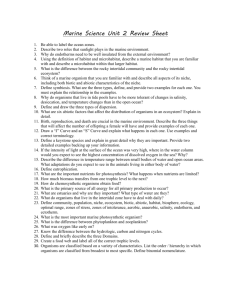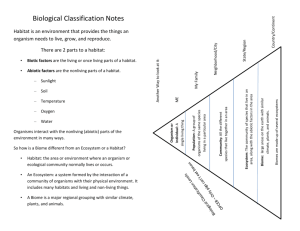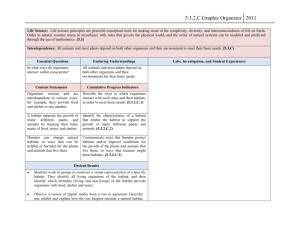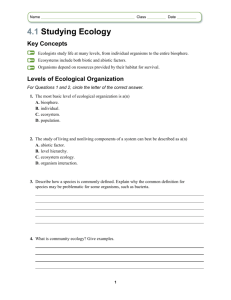File
advertisement
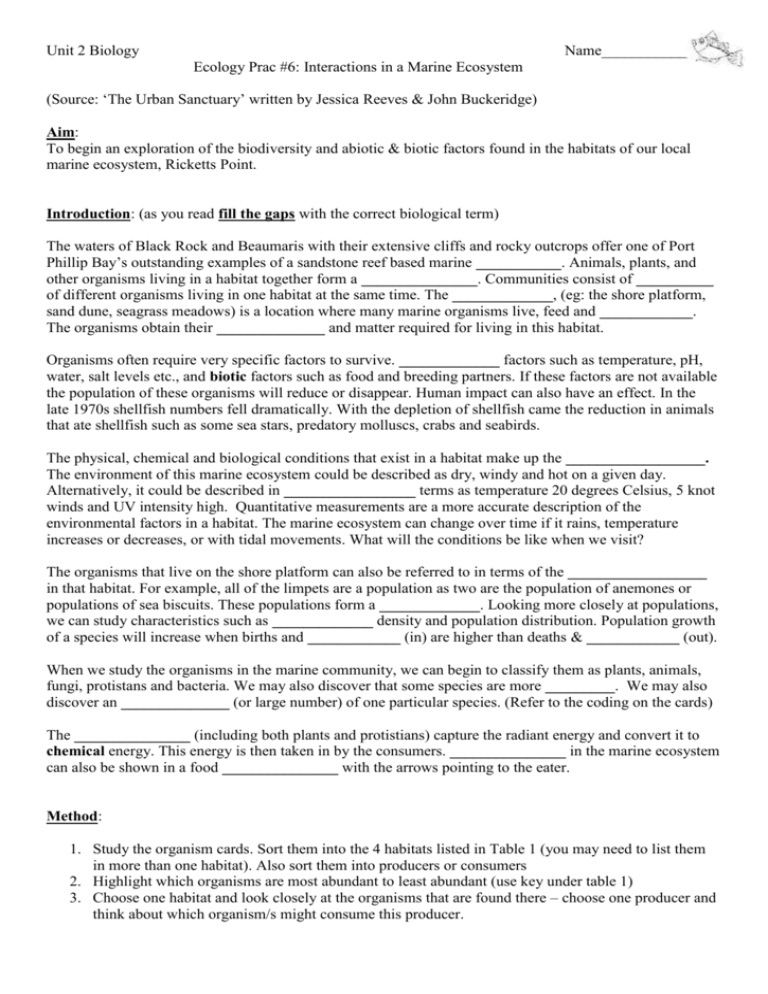
Unit 2 Biology Name____________ Ecology Prac #6: Interactions in a Marine Ecosystem (Source: ‘The Urban Sanctuary’ written by Jessica Reeves & John Buckeridge) Aim: To begin an exploration of the biodiversity and abiotic & biotic factors found in the habitats of our local marine ecosystem, Ricketts Point. Introduction: (as you read fill the gaps with the correct biological term) The waters of Black Rock and Beaumaris with their extensive cliffs and rocky outcrops offer one of Port Phillip Bay’s outstanding examples of a sandstone reef based marine ___________. Animals, plants, and other organisms living in a habitat together form a _______________. Communities consist of __________ of different organisms living in one habitat at the same time. The _____________, (eg: the shore platform, sand dune, seagrass meadows) is a location where many marine organisms live, feed and ____________. The organisms obtain their ______________ and matter required for living in this habitat. Organisms often require very specific factors to survive. _____________ factors such as temperature, pH, water, salt levels etc., and biotic factors such as food and breeding partners. If these factors are not available the population of these organisms will reduce or disappear. Human impact can also have an effect. In the late 1970s shellfish numbers fell dramatically. With the depletion of shellfish came the reduction in animals that ate shellfish such as some sea stars, predatory molluscs, crabs and seabirds. The physical, chemical and biological conditions that exist in a habitat make up the __________________. The environment of this marine ecosystem could be described as dry, windy and hot on a given day. Alternatively, it could be described in _________________ terms as temperature 20 degrees Celsius, 5 knot winds and UV intensity high. Quantitative measurements are a more accurate description of the environmental factors in a habitat. The marine ecosystem can change over time if it rains, temperature increases or decreases, or with tidal movements. What will the conditions be like when we visit? The organisms that live on the shore platform can also be referred to in terms of the __________________ in that habitat. For example, all of the limpets are a population as two are the population of anemones or populations of sea biscuits. These populations form a _____________. Looking more closely at populations, we can study characteristics such as _____________ density and population distribution. Population growth of a species will increase when births and ____________ (in) are higher than deaths & ____________ (out). When we study the organisms in the marine community, we can begin to classify them as plants, animals, fungi, protistans and bacteria. We may also discover that some species are more _________. We may also discover an ______________ (or large number) of one particular species. (Refer to the coding on the cards) The _______________ (including both plants and protistians) capture the radiant energy and convert it to chemical energy. This energy is then taken in by the consumers. _______________ in the marine ecosystem can also be shown in a food _______________ with the arrows pointing to the eater. Method: 1. Study the organism cards. Sort them into the 4 habitats listed in Table 1 (you may need to list them in more than one habitat). Also sort them into producers or consumers 2. Highlight which organisms are most abundant to least abundant (use key under table 1) 3. Choose one habitat and look closely at the organisms that are found there – choose one producer and think about which organism/s might consume this producer. Table 1 Habitat Organism (common name) Producers Consumers Sand habitats Intertidal rock platforms Exposed at low tide Seagrass meadows Shallow subtidal platforms Organisms always submerged High (3 green squares) Medium (2 green squares) Low (1 green square) Discussion Questions: (Based on the data collected in Table 1 & Figure 2) You may also need to refer to the information describing the different habitats. 1. 2. 3. 4. a) Which habitat had the most organisms? b) List 3 abiotic factors found in this habitat a) Which habitat had the least organisms? b) List 3 abiotic factors found in this habitat Some organisms were less abundant than others; name the organism that is least abundant. Look at figure 2 ‘Locality Map of Ricketts Point Sanctuary’. Which habitat type appears to cover the a) greatest and b) least area within the sanctuary? 5. On excursion we will have greater access to some habitats. Thinking about this and the abundance of various organisms, list 3 organisms we could possibly find if we look carefully. Conclusion Discuss the key features of this marine ecosystem and why it is vital that Ricketts Point is preserved for future generations.


